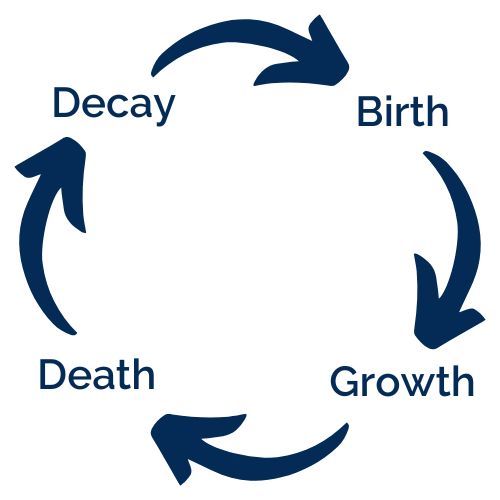Share On:
Information Cycle
Mini-Workbook
One of the biggest challenges we face today is our inability to adapt and change as a normal cycle of life. Change is often dubbed as the only constant in life, yet organizations and individuals continue to struggle with how to work with change every day. Regenerative Organizations embrace nature’s cycle of life (birth, growth, death, decay) in their daily operations to support in this process.
The Information Life Cycle
In ecosystems, the cycle of life is a natural disturbance that allows for an ecosystem to regenerate new life. Plant materials undergo a transformational process that involves the breakdown and reorganizing of the plant’s composition into minerals. These minerals become the ingredients for fertility in the soil. Without death and decay, there is no birth and growth. The entire cycle creates the necessary conditions for new life and growth to emerge.
Humans mimic this natural pattern by creating planned disturbance events. One of the most common examples of this is the management of a forest's new growth with controlled burns.
In an ecosystem's life cycle, the element that is being regenerated is nutrients. In an organization's life cycle, the element that is being regenerated is information. Without death and decay (breaking down of our current beliefs, behaviors and practices), there is no birth and growth (new beliefs, behaviors, and practices).
So, how do we create the conditions for information in our organizations to go through the death, decay, birth, and growth cycle?

Regenerate Your Beliefs, Behaviors, and Practices
nRhythm created the Information Life Cycle Mini-Workbook, designed to help you break down your beliefs, behaviors and practices in order to give life to new ones. The self-reflective prompts and exercises in this mini-workbook will help you start to discover new opportunities within yourself, create the conditions for new life and growth to emerge, and help align your work with your potential.
Sign up for our newsletter where you’ll receive the latest free resources, news about educational offerings and motivational prompts to bring regenerative practices into your workweek. We look forward to welcoming you to the growing global nRhythm community!
Mailing Address
4845 Pearl East Cir Ste
118 PMB 75152
Boulder, CO 80301-6112
© 2022/2023 nRhythm
